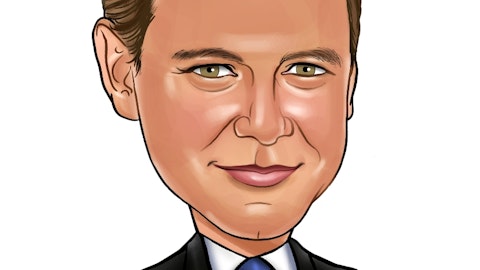Now as we’re starting to see demand pick back up again, and us play a lot more offense with respect to our commercial business. We are bringing forward some of those purchases of long lead time items. I think one of the key factors here, that will impact our cash burn, both in the back half of the year and into 2024, is the continued improvement in gross margin that we are seeing and expect to continue to see. Because as you start to see that number move toward a positive trajectory, it has a material impact on our cash position, and that is one of the key – that is why we’re so focused on not just driving more volume through higher demand, but also reduce – we significantly reduced our manufacturing overhead footprint. We are looking at more processes that we can bring in-house to reduce costs.
We are rigorously focused on driving yields higher on key products and ensuring that we are maximizing, the efficiency of that investment, because that is the primary toggle to seeing the cash burn go from this – from something like in the mid-teens what you’re seeing right now to down towards the low double-digits.
John Young: Great. I appreciate all that color. And then just on the traction you’re seeing, if I’m hearing your comments correctly, it seems like a lot of the procedure volume has been in the United States, you’ve seen nice growth there. Maybe just any incremental color on accounts where you’re seeing this, and in terms of both more procedures from your mapping updates and/or adding more physicians using the same comps already in place? Are you seeing these in academic centers or anything that you see that’s identifiable of a continued pattern that’s going forward? Thanks taking our questions.
David Roman: Yes. Thanks for the question, John. And maybe just one last follow-up on your last question. As we’ve talked about for probably over a year now. When we have entered into the agreement with Medtronic on left heart access in April 2022, we talked about having cash kind of through the middle of 2024. That is certainly extended today and well into the third – through the third quarter of 2024. And we continue to make very good progress pushing that out through our own internal initiatives around underlying strength in the business. We continue to make very, disciplined decisions with respect to operating expenses. I believe our headcount now sits at almost its lowest level in several, several years. So, we are making every effort to optimize resources, which is allowing us to continue to push out our cash runway.
And while I can’t comment, we will say, obviously, in November, yes, we are undertaking every feasible effort to both drive growth in the business as well as push out that cash runway. And we’ve done, I think, a very consistent incredible job in that, again, we’ll continue to do so. With respect to procedure volumes, and what we’re seeing on usage, the pattern has really been more about where physicians are using AcQMap. And as – if you rewind kind of like 12 to 18 months ago, one of the things that I think was a real aha moment for me, when I moved into this role, was how much AcQMap had really been relegated to an adjunct system being used in the super, super complex cases. Second, reduce, third reduce. That means like your third or fourth procedure.
And that just isn’t – there aren’t enough of those procedures or they take place at so many different centers. You can’t really build a big enough business on that. So the investments that we’ve been making in product development have all been about making AcQMap more relevant for everyday routine cases and still focus in this complex segment of the market, whether that’s first redo or de novo persistent, of which there are hundreds of thousands of both of those procedures combined. That has been one of the primary differences that is resulting in the uptick in procedure volumes. As physician finding that not only can they use AcQMap for these extraordinarily complex cases, but they can use AcQMap and still albeit complex cases, but ones that are more – that are more routine, that’s for a kind of lack of a better way to put us, get us on the playing field.




